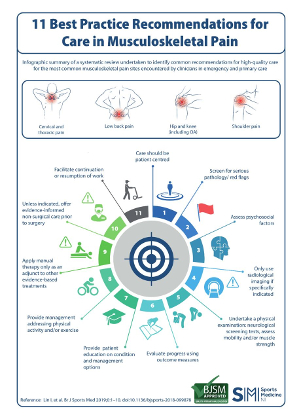This systematic review evaluated recommendations for high-quality care for common musculoskeletal pain sites treated in emergency departments and primary care. Evidence-based clinical practice guidelines for adult musculoskeletal pain that were written in English and published since 2011 were included. Guidelines were excluded if they focussed on traumatic musculoskeletal pain, single modalities (eg, surgery), traditional medicine, and specific disease processes. Quality was evaluated using the Appraisal of Guidelines for Research and Evaluation II (AGREE-II) instrument. Guidelines scoring at least 50% in the rigour of development, editorial independence, and stakeholder involvement domains were included in the analyses. Recommendations from the included guidelines were extracted and coded.
There were 11 high-quality guidelines focussing on low back (n = 4), hip or knee (n = 4), neck (n = 2) and shoulder (n = 1) pain. These guidelines contained 11 consistent recommendations that can be used by healthcare consumers, clinicians, researchers and policy makers to improve the quality of care for musculoskeletal pain. The recommendations are:
- Ensure care is patient centred
- Screen for red flag conditions
- Assess psychosocial factors
- Use imaging selectively
- Undertake a physical examination
- Monitor patient progress
- Provide education or information
- Address physical activity or exercise
- Use manual therapy only as an adjunct to other treatments
- Offer high-quality non-surgical care prior to surgery
- Try to keep patients at work.
A great infographic summarising these recommendations has been produced by the British Journal of Sports Medicine.

Lin I et al. What does best practice care for musculoskeletal pain look like? Eleven consistent recommendations from high-quality clinical practice guidelines: systematic review. Br J Sports Med 2020;54(2):79-86



